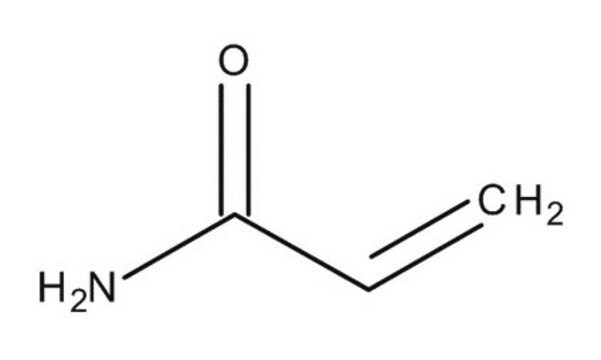A3553
Acrylamide
suitable for electrophoresis, ≥99% (HPLC), powder
Synonym(s):
2-Propenamide, Polyacrylamide, acrylic amide, akrylamid, Acrylic acid amide
About This Item
Recommended Products
vapor density
2.45 (vs air)
Quality Level
vapor pressure
0.03 mmHg ( 40 °C)
assay
≥99% (HPLC)
form
powder
technique(s)
electrophoresis: suitable
impurities
≤0.005% Acrylic acid
≤0.005% Insoluble in water
conductivity
≤10 μmho (35% solution)
bp
125 °C/25 mmHg (lit.)
mp
82-86 °C (lit.)
solubility
water: soluble 2.5 g/10 mL, clear, colorless
cation traces
Fe: ≤1 ppm
Mg: ≤3 ppm
heavy metals (as Pb): ≤5 ppm
SMILES string
NC(=O)C=C
InChI
1S/C3H5NO/c1-2-3(4)5/h2H,1H2,(H2,4,5)
InChI key
HRPVXLWXLXDGHG-UHFFFAOYSA-N
Looking for similar products? Visit Product Comparison Guide
General description
Application
Compatibility
suggested gloves for splash protection
signalword
Danger
Hazard Classifications
Acute Tox. 3 Oral - Acute Tox. 4 Dermal - Acute Tox. 4 Inhalation - Carc. 1B - Eye Irrit. 2 - Muta. 1B - Repr. 2 - Skin Irrit. 2 - Skin Sens. 1 - STOT RE 1 Oral
target_organs
Peripheral nervous system
Storage Class
6.1C - Combustible acute toxic Cat.3 / toxic compounds or compounds which causing chronic effects
wgk_germany
WGK 3
flash_point_f
280.4 °F - closed cup
flash_point_c
138 °C - closed cup
ppe
Eyeshields, Faceshields, Gloves, type P3 (EN 143) respirator cartridges
Choose from one of the most recent versions:
Certificates of Analysis (COA)
Don't see the Right Version?
If you require a particular version, you can look up a specific certificate by the Lot or Batch number.
Already Own This Product?
Find documentation for the products that you have recently purchased in the Document Library.
Customers Also Viewed
Our team of scientists has experience in all areas of research including Life Science, Material Science, Chemical Synthesis, Chromatography, Analytical and many others.
Contact Technical Service






